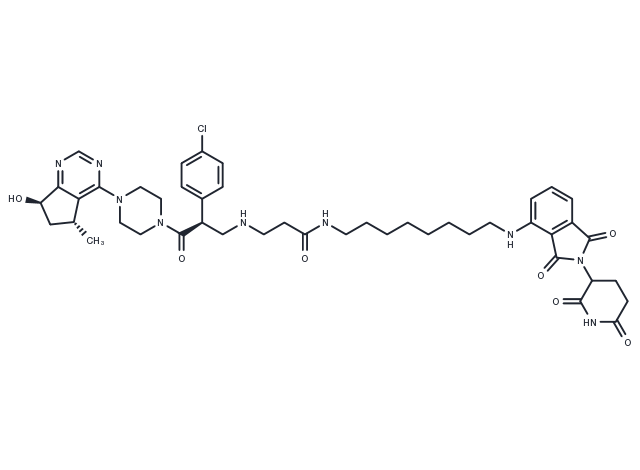Powder: -20°C for 3 years | In solvent: -80°C for 1 year


MS170 is a highly effective and specific PROTAC AKT degrader compound that exhibits potent activity. It efficiently reduces the levels of total AKT (T-AKT) within cells, with a DC 50 value of 32 nM. Furthermore, MS170 demonstrates strong binding affinity towards AKT isoforms, specifically AKT1, AKT2, and AKT3, with respective dissociation constants (Kd) of 1.3 nM, 77 nM, and 6.5 nM.

| Pack Size | Availability | Price/USD | Quantity |
|---|---|---|---|
| 5 mg | Inquiry | $ 996.00 |
| Description | MS170 is a highly effective and specific PROTAC AKT degrader compound that exhibits potent activity. It efficiently reduces the levels of total AKT (T-AKT) within cells, with a DC 50 value of 32 nM. Furthermore, MS170 demonstrates strong binding affinity towards AKT isoforms, specifically AKT1, AKT2, and AKT3, with respective dissociation constants (Kd) of 1.3 nM, 77 nM, and 6.5 nM. |
| Targets&IC50 | Akt3:6.5 nM (Kd), Akt2:77 nM (Kd), Akt1:1.3 nM (Kd) |
| In vitro | Cereblon (CRBN)-recruiting degrader MS170 is a potent AKT degrader, demonstrating efficacy without exhibiting a hook effect. It selectively degrades AKT proteins, hindering downstream signaling and effectively inhibiting cancer cell growth. MS170 operates in a concentration- and time-dependent manner to degrade AKT via the ubiquitin-proteasome system (UPS)[1], and has been shown to significantly inhibit proliferation across various cancer cell lines at concentrations ranging from 10 nM to 10 μM[1]. Specifically, MS170 depletes total AKT (T-AKT) in a concentration-dependent fashion with a DC50 value of 32±18 nM[1]. In cell proliferation assays using BT474, PC3, and MDA-MB-468 cells, MS170 demonstrated growth inhibition with GI50s of 0.7±0.2 μM, 7.4±2.2 μM, and 5.7±2.4 μM, respectively, over a 5-day incubation period. Western blot analyses further corroborate these findings, showing potent AKT degradation in BT474 cells treated with MS170 across a broad range of concentrations for 24 hours. |
| In vivo | MS170, administered through a single intraperitoneal (IP) injection at a dosage of 50 mg/kg, demonstrates bioavailability in male Swiss albino mice. Pharmacokinetic analysis reveals that the peak concentration (C max) reaches 1.4 μM at 2 hours post-administration, underscoring its effective distribution within the mouse model over an 8-hour period. |
| Molecular Weight | 870.45 |
| Formula | C45H56ClN9O7 |
| CAS No. | 2376136-61-5 |
Powder: -20°C for 3 years | In solvent: -80°C for 1 year
You can also refer to dose conversion for different animals. More
bottom
Please see Inhibitor Handling Instructions for more frequently ask questions. Topics include: how to prepare stock solutions, how to store products, and cautions on cell-based assays & animal experiments, etc.
MS170 2376136-61-5 MS 170 MS-170 inhibitor inhibit
